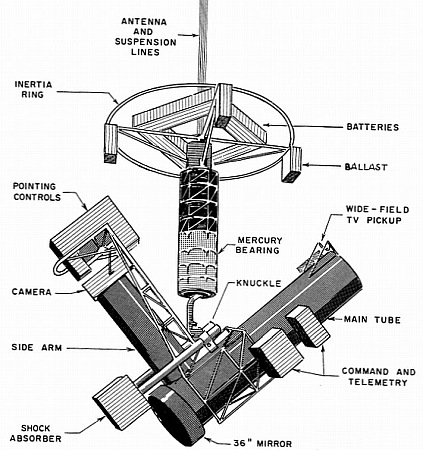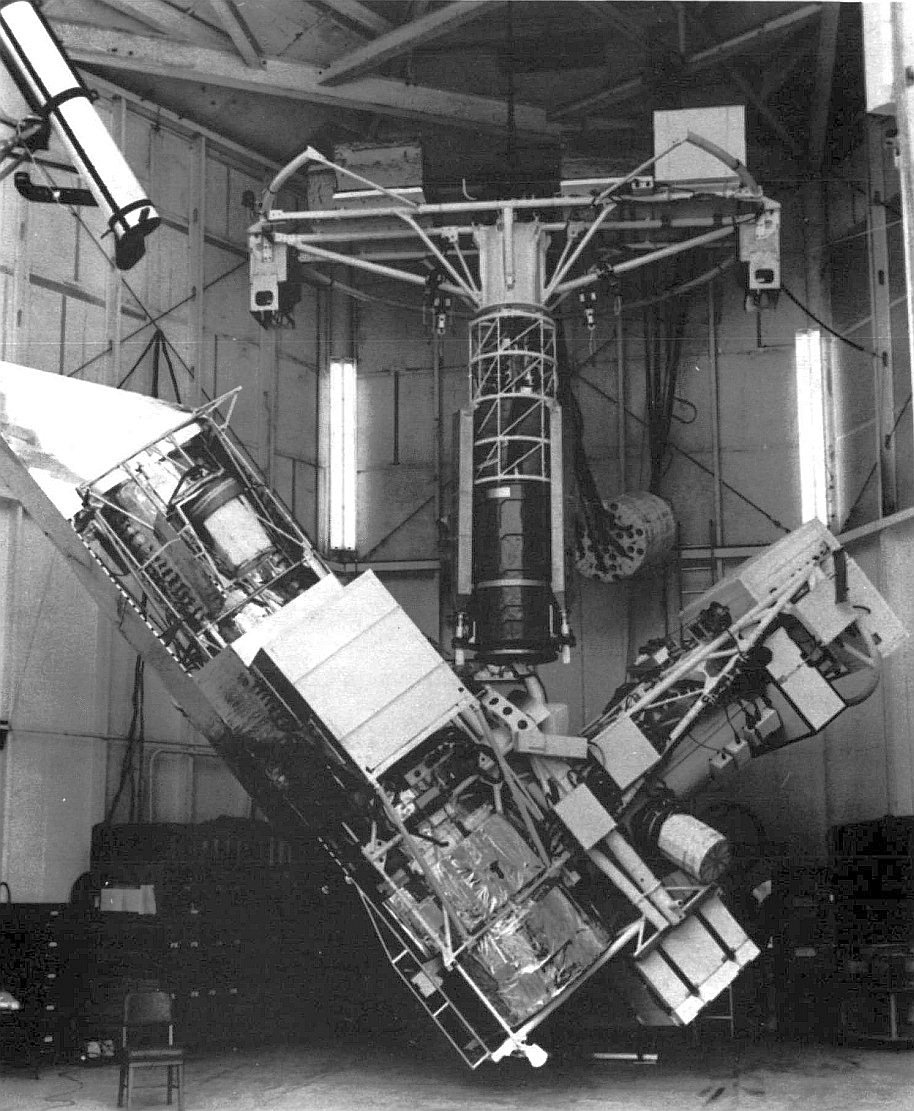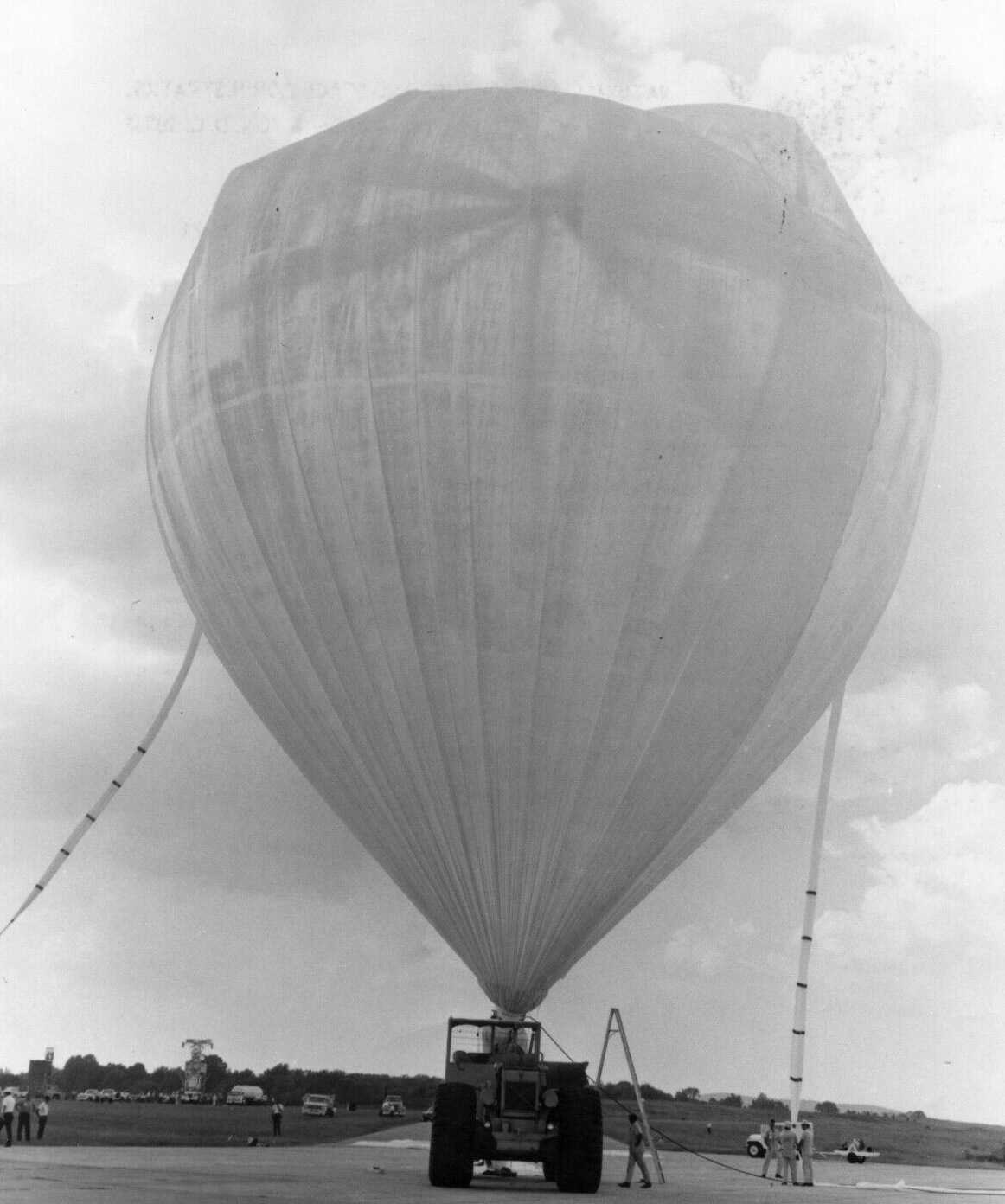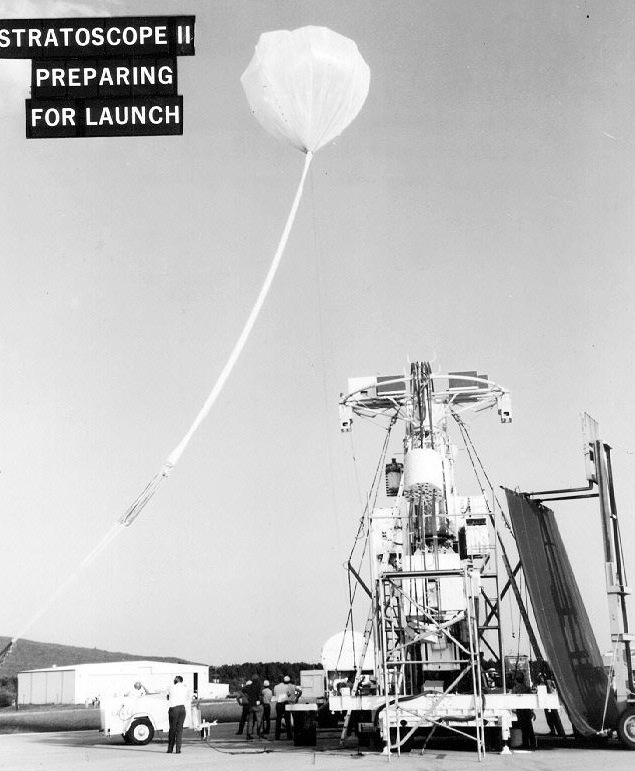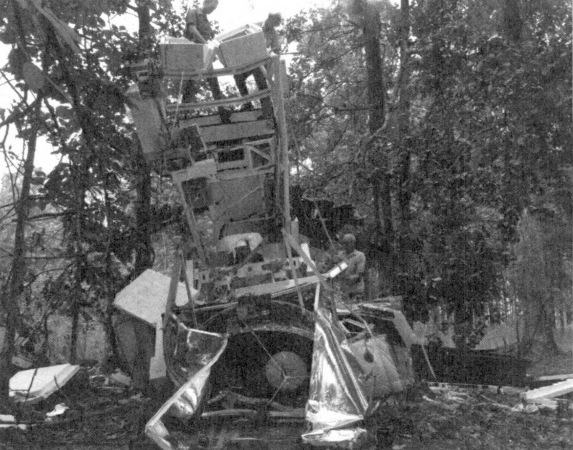Purpose of the flight and payload description
The Stratoscope II system was one of the most sophisticated balloon-borne telescope systems ever flown. It's goal was to photograph planets and stellar nebulae from Earth's stratosphere with previously unseen precision in an effort that can be viewed in perspective as a distant precursor to the Hubble Space Telescope. The project was under the direction of Princeton University, and was sponsored by the National Science Foundation (NSF), the Office of Naval Research (ONR) and counted with additional support from the National Aeronautics and Space Administration (NASA). The main contract for the construction of the telescope was awarded to the Perkin-Elmer Corporation from Norwalk, Connecticut while Vitro Laboratories from Silver Spring, Maryland served as program manager and supervised the development of the balloon system, the launching and recovery techniques, and planned and conducted the flights.
THE TELESCOPE
At left we can see a basic scheme of the telescope as deployed in-flight (click to enlarge) and the configuration of the double-balloon tandem system (more details below). The assembly consisted of an 18-foot main tube and an 11-foot side arm which together formed a fixed L-shaped structure. The basic telescope was housed in the main tube with the objective mirror, the secondary mirror, which was also the focusing element, and a television camera with a 10º field, used to locate the general section of the sky to be studied. The side arm assembly housed the guidance package, camera equipment, and another television camera, this one with a 1º field, which looked through the reflecting telescope and fixed the specific celestial object to be photographed. At it's core was a 36-inch diameter optical mirror fabricated by the Corning Glass Works from New York. Fused silica was choosen as material for the mirror because it was unaffected by the sharp changes in temperature the telescope experienced in flight. That was the first time a fused-silica blank of that size was successfully formed and with high accuracy to a true parabolic shape.
The L-section, weighing 5.500 pounds, was supported by the "knuckle" which contained the drives and the axes that allowed the telescope to point higher or lower in the sky (elevation) and to rotate along the axis of its tube (roll). The L-section and knuckle were supported by the azimuth bearing, which allowed freedom to turn around the vertical axis (azimuth). The telescope was moved to any required elevation angle by a motor-gear drive, but during tracking operated within the freedom of +50 flexure bearings in both roll and elevation. The azimuth bearing was a mercury-floated type wherein the telescope was floated by the buoyant force of a pool of mercury. The telescope tube was locked vertically against the azimuth frame during launch. After deployment, it had a viewing range extending from 70º down to 20º above the horizontal over an azimuth of 360º. A 14-foot diameter inertia ring was fastened to the top half of the azimuth frame. That ring supported the batteries which powered the instrument, ballast containers, provided the counter-inertia in azimuth and finally served to absorb part of the shock of landing at the end of the flight.
A fully instrumented mobile ground control van was located strategically in advance of each mission to remain within the coverage range across the balloon's flight path. From that van astronomers operated the telescope almost in real time through a specially built command and telemetry system with 40 and 64 channels respectively which permited many functions of the telescope and related equipment to be controlled remotely. Two complete radio links were employed to carry out command activities, the channels being divided equally between them. If one link failed, commands normally carried by it could be switched to the other link. The ''eyes" of the ground team were a remote-control television system, and a high-resolution image orthicon tube developed by the RCA Laboratories, Princeton, New Jersey. To acquire the target image, the coarse and fine television screens were used to find a pre-selected guide star. The fine guidance system consisted of lenses within the telescope which moved the image for precision tracking. The image was split between the recording camera and the four tracking eyes. The eyes provided lock-on to two guide stars to provide stabilization in two axes. All exposures obtained during the observational run were recorded on 70-mm film and stored in the camera magazine which was recovered after the telescope returned to the ground.
THE TANDEM BALLOON SYSTEM
In planning Stratoscope II, one of the prime considerations was to construct a balloon strong enough to lift such a heavy weight to the required altitude of 80,000 feet. Polyethylene film, commonly used for balloons, was then limited to a load-carrying capacity of about 4,000 pounds, and thus was unsatisfactory for the project. To meet this problem, the G.T. Schjeldahl Company of Northfield, Minnesota under contract to ONR, developed a reinforced laminated plastic film having high tensile strength and tear resistance. Schjeldahl also developed, a new balloon system capable of lifting the heavy telescope payload off the ground quickly while remaining unbuffeted by ground winds as high as 15 knots. The system employed two balloons -a small one and a large one, with the former mounted on top of the latter. The small balloon was composed of a 0.5 mil Mylar and dacron laminate called S-12 with a volume of 250,000 cubic feet. The main balloon consisted of a 0.3 mil Mylar and dacron material known as S-11 with a volume of 5,250,000 cubic feet. The two balloons were connected by a 2-1/2 foot metal tube, 3 feet in diameter, attached to a 3-foot hole in each balloon.
LAUNCH AND FLIGHT PROFILE
The launch balloon was designed to hold enough helium to lift the payload to altitude. In preparation for the flight the launch balloon was inflated while connected to the main balloon which remained in its shipping box. Once the smaller balloon was full, it was attached to a cable and allowed to ascend slowly, lifting the main balloon (which was snugly wrapped in a plastic sheath), until the entire system stood erect above the telescope. Wrapping the uninflated main balloon prevented its ''sailing'' and sweeping the payload out horizontally. Immediately before launch the entire system towered over 600-feet tall. At launch an explosive charge released the restraining cable and the balloon took-off gently, without sway or rotation. Once the balloon left the ground, the protective sheath was ripped from the main balloon. As the balloon ascended the change in atmospheric pressure with altitude induced a flow of gas from the launch balloon into the main balloon. At 30.000 feet both were fully inflated.
Althought Stratoscope II carried two cargo parachutes for emergency landing if necessary, the common procedure once the mission was completed was to lower the telescope gently to earth with the help of the balloon itself. At dawn, an aircraft approached the balloon and sent a command to valve-off helium establishing a rate of descent of about 600 feet per minute. The balloon was carefully ''stepped down" to around 5000 feet, and held at this altitude until rendezvous was established with an helicopter to which command was transferred; it then eased the balloon down close to the ground (avoiding cities, electric lines, railways. etc.), until it drifted over an open area, whereupon the telescope was landed. Upon cantact with the ground an explosive bolt was fired, releasing the balloon to prevent it dragging the instrument. Freed of its load, the balloon ascended, to be immediately deflated by the ignition of a large squib at its apex, thus preventing it from continuing an uncontrolled free flight.
Video footage of the launch operations
Details of the balloon flight
Balloon launched on: 9/9/1971 at 19:33 cdt
Launch site: Redstone Army Airfield, Huntsville, Alabama, US
Balloon launched by: National Center for Atmospheric Research (NCAR)
Balloon manufacturer/size/composition: Zero Pressure Balloon Schjeldahl - Top: 273.500 cuft (G001200-50) - Main: 5.580.000 cuft (G001100-35)
Flight identification number: 629SS
End of flight (L for landing time, W for last contact, otherwise termination time): 9/10/1971 at 11
Balloon flight duration (F: time at float only, otherwise total flight time in d:days / h:hours or m:minutes - ): F 10 h 50 m
Landing site: 7 miles SE from Bald Knob, Arkansas, US
Payload weight: 14.103 lbs
The program for the 1971 experiment was under overall supervision of the sponsor, the NASA Office of Space Science Applications. Direct control of the program was exercised by the Marshall Space Flight Center at Huntsville, Alabama, who also prepared the telescope for flight. The scientific investigation was executed by Princeton University Astronomy Department, and by agreement between NASA and UCAR operation was carried out by the NCAR Scientific Balloon Facility.
Movement of personnel and equipment to Huntsville commenced in July and was completed during August. A crew of twenty-five personnel from the Balloon Facility was required. Five truck loads of equipment from the Palestine, Texas base were required as well as two heavy winch vehicles. The telescope and all systems were ready for flight August 18, but the anticipated afternoon-thunderstorm type of weather prevailed and forced delay of the launch until September 9. Launch operations commenced at 13:00, having been postponed from an earlier scheduled time in order to be sure of no thunderstorm development.
The system was launched at 18:35 CDT on September 9, 1971 from the airfield of the Redstone Arsenal in Huntsville, Alabama and entered float at 83,000 feet, at which time astronomy functions commenced. The telescope was controlled from the Marshall Center station on Green Mountain, a high ridge near Huntsville and tracked by a ground recovery team and a light aircraft.
The flight profile showed a rapid ascent, drifting westward at about 20 to 25 miles per hour and decreasing during the night to 68,000 feet. At day break a "valve-down" descent was started at a rate of 1.150 ft/min. The landing was accomplished according to plan in a pre-selected isolated area. The site was located on a farm about seven miles southeast of Bald Knob, Arkansas. It impacted in a tree top causing the instrument to break into two parts. The telescope's main tube and side arm fell some 40 feet to the ground. Damage to the telescope's optical components was considered minor except to the 36-inch primary mirror which was chipped on its edges. Project officials said the primary mirror will probably be serviceable after grinding and polishing.
In this flight three primary scientific targets were photographed by the telescope; Galaxy M31 (commonly known as Andromeda), Galaxy M32, and Planetary Nebula NGC 7662. That would be the last scientific flight of the program.
Postal cover issued on launch day commemorating the flight
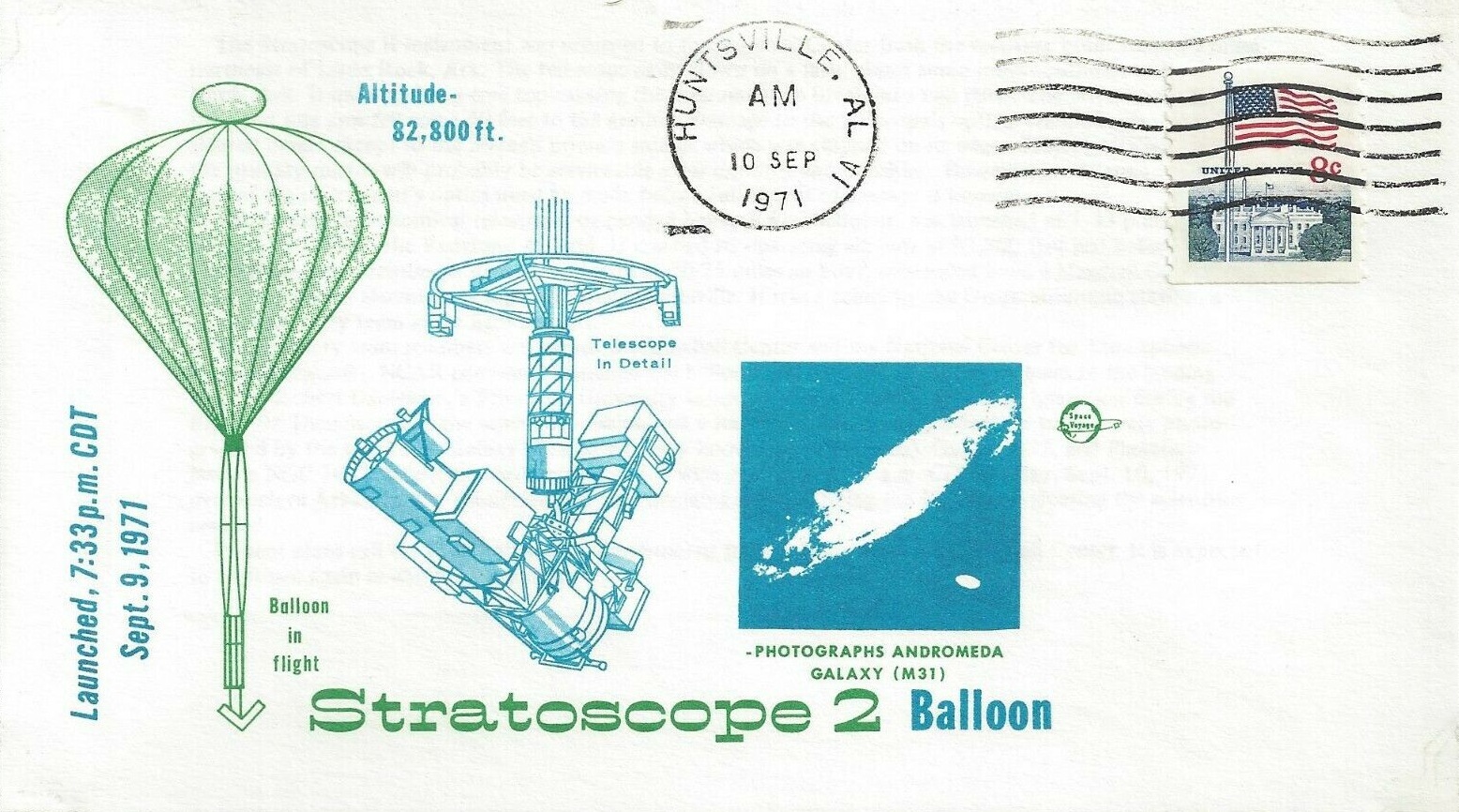
External references
- Balloon-Borne Telescope was Launched In 1971 Mike Wright, MSFC Historian
- High-Resolution Imagery of Uranus Obtained by Stratoscope II Astrophysical Journal, Vol. 178, pp. 887
- NCAR Scientific Balloon Facility Annual Report, 1971 National Center for Atmospheric Research, February 1972
- The dynamics of the nucleus of M31 Astrophysical Journal, Part 1, vol. 256, May 15, 1982, p. 435
- The nucleus of M31 Astrophysical Journal, vol. 194, Dec. 1, 1974, pt. 1, p. 257
1766If you consider this website interesting or useful, you can help me to keep it up and running with a small donation to cover the operational costs. Just the equivalent of the price of a cup of coffee helps a lot.

